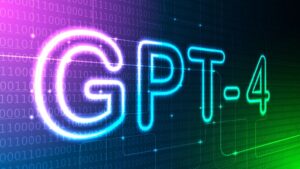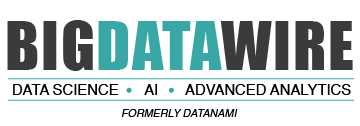

(Ebru-Omer/Shutterstock)
Just two years ago, nobody outside of a small group of AI researchers and practitioners knew what a “large language model” was. But thanks to the launch of ChatGPT in November, everybody and her cat is an LLM expert now. So when OpenAI finally took the veil off GPT-4 this week, you just knew it was going to be a big deal.
The media response to the official unveiling of GPT-4 this week has delivered on the hype, just as advertised. If GPT-4 were a celebrity (and mind you, it hasn’t declared itself to be alive–at least not yet), it might be bigger than Elvis.
“It’s basically mind-blowing,” one early GPT-4 tester, Miðeind COO Linda Heimisdottir, told Sifted.eu. “It feels like the sky’s the limit.”
GPT-4 “stunned many users” in early tests, CNN reports. Whether it’s passing the bar exam at the 90th percentile, explaining a joke, or creating a functional website from a drawing, the new AI “promises to blow previous iterations out of the water, potentially changing the way we use the internet to work, play and create,” writes CNN’s Samantha Murphy Kelly.
GPT-4 can analyze up to 25 pages of text, nearly 10x the amount of its processor. It scored a 1410 on the SAT, 150 points higher than its predecessor. While GPT3.5 resembled the intelligence of a sixth-grader, GPT4 sounds more like “a smart 10th-grader,” Keith Peiris, co-founder of AI startup Tome, told the Wall Street Journal.
While GPT-4 hasn’t (yet) tried to end New York Times columnist Kevin Roose’s marriage, as the GPT-powered Bing chat mode infamously did earlier this year, the new AI still gave Roose that “dizzy and vertiginous feeling” that he experienced earlier. “The more time I spend with A.I. systems like GPT-4,” he writes, “the less I’m convinced that we know half of what’s coming.”

GPT-4 is good, but not good enough to run a nuclear power plant, one commentator said (BESTWEB/Shutterstock)
Not knowing what an LLM will say next is part of the fun, as hallucinations are a feature of all LLMs. While GPT-4 appears to completely make things up less frequently than GPT-3.5 (30% error rate) or ChatGPT (20% error rate), it continues to be a concern with the new model. “It’s going to be a long time before you want any GPT to run your nuclear power plant,” Oren Etzioni, professor emeritus at the University of Washington, told Wired.
That tendency to make things up and be creative can be harnessed to boost human performance and creativity, reports Lifewire’s Sascha Brodsky. “GPT-4 has an uncanny ability to accomplish tasks that, until recently, would have seemed like science fiction,” Brodsky writes.
That extra productivity might not be embraced by all, according to Bloomberg’s Parmy Olson, who writes that GPT-4 “could turn work into a hyperproductive hellscape.” Have 1,000 emails to read by 4 p.m.? GPT-4 to the rescue!
Several media cites and AI experts chided OpenAI for not sharing more details about how GPT-4 was trained. “The 98-page paper introducing GPT-4 proudly declares that they’re disclosing *nothing* about the contents of their training set,” Nomic AI Vice President of Information Design Ben Schmidt tweeted.
OpenAI appears to be concerned that opening GPT-4 to the world will give competitors a leg up, but some experts are concerned that preserving secrecy gives a place for biases to fester and grow. “Researchers are excited about the AI,” writes Katharine Sanderson in a piece for Nature, “but many are frustrated that its underlying engineering is cloaked in secrecy.”
The folks at OpenAI acknowledge there’s room for improvement with its AI. “It’s not perfect,” Greg Brockman, president and co-founder of OpenAI, reporetdly said during the announcement, which was streamed live on YouTube. “But neither are you.”
Related Items:
GPT-4 Has Arrived: Here’s What to Know
ChatGPT Brings Ethical AI Questions to the Forefront
Has Microsoft’s New Bing ‘Chat Mode’ Already Gone Off the Rails?
July 3, 2025
- FutureHouse Launches AI Platform to Accelerate Scientific Discovery
- KIOXIA AiSAQ Software Advances AI RAG with New Version of Vector Search Library
- NIH Highlights AI and Advanced Computing in New Data Science Strategic Plan
- UChicago Data Science Alum Transforms Baseball Passion into Career with Seattle Mariners
July 2, 2025
- Bright Data Launches AI Suite to Power Real-Time Web Access for Autonomous Agents
- Gartner Finds 45% of Organizations with High AI Maturity Sustain AI Projects for at Least 3 Years
- UF Highlights Role of Academic Data in Overcoming AI’s Looming Data Shortage
July 1, 2025
- Nexdata Presents Real-World Scalable AI Training Data Solutions at CVPR 2025
- IBM and DBmaestro Expand Partnership to Deliver Enterprise-Grade Database DevOps and Observability
- John Snow Labs Debuts Martlet.ai to Advance Compliance and Efficiency in HCC Coding
- HighByte Releases Industrial MCP Server for Agentic AI
- Qlik Releases Trust Score for AI in Qlik Talend Cloud
- Dresner Advisory Publishes 2025 Wisdom of Crowds Enterprise Performance Management Market Study
- Precisely Accelerates Location-Aware AI with Model Context Protocol
- MongoDB Announces Commitment to Achieve FedRAMP High and Impact Level 5 Authorizations
June 30, 2025
- Campfire Raises $35 Million Series A Led by Accel to Build the Next-Generation AI-Driven ERP
- Intel Xeon 6 Slashes Power Consumption for Nokia Core Network Customers
- Equal Opportunity Ventures Leads Investment in Manta AI to Redefine the Future of Data Science
- Tracer Protect for ChatGPT to Combat Rising Enterprise Brand Threats from AI Chatbots
June 27, 2025
- Inside the Chargeback System That Made Harvard’s Storage Sustainable
- What Are Reasoning Models and Why You Should Care
- Databricks Takes Top Spot in Gartner DSML Platform Report
- LinkedIn Introduces Northguard, Its Replacement for Kafka
- Change to Apache Iceberg Could Streamline Queries, Open Data
- Agentic AI Orchestration Layer Should be Independent, Dataiku CEO Says
- Fine-Tuning LLM Performance: How Knowledge Graphs Can Help Avoid Missteps
- The Evolution of Time-Series Models: AI Leading a New Forecasting Era
- Top-Down or Bottom-Up Data Model Design: Which is Best?
- Stream Processing at the Edge: Why Embracing Failure is the Winning Strategy
- More Features…
- Mathematica Helps Crack Zodiac Killer’s Code
- ‘The Relational Model Always Wins,’ RelationalAI CEO Says
- Confluent Says ‘Au Revoir’ to Zookeeper with Launch of Confluent Platform 8.0
- The Top Five Data Labeling Firms According to Everest Group
- DuckLake Makes a Splash in the Lakehouse Stack – But Can It Break Through?
- Solidigm Celebrates World’s Largest SSD with ‘122 Day’
- Toloka Expands Data Labeling Service
- Supabase’s $200M Raise Signals Big Ambitions
- With $17M in Funding, DataBahn Pushes AI Agents to Reinvent the Enterprise Data Pipeline
- Databricks Is Making a Long-Term Play to Fix AI’s Biggest Constraint
- More News In Brief…
- Astronomer Unveils New Capabilities in Astro to Streamline Enterprise Data Orchestration
- Seagate Unveils IronWolf Pro 24TB Hard Drive for SMBs and Enterprises
- Databricks Unveils Databricks One: A New Way to Bring AI to Every Corner of the Business
- Gartner Predicts 40% of Generative AI Solutions Will Be Multimodal By 2027
- BigBear.ai And Palantir Announce Strategic Partnership
- Databricks Donates Declarative Pipelines to Apache Spark Open Source Project
- Deloitte Survey Finds AI Use and Tech Investments Top Priorities for Private Companies in 2024
- Code.org, in Partnership with Amazon, Launches New AI Curriculum for Grades 8-12
- Atlan Launches AI Data Quality Studio for Snowflake
- Databricks Launches Lakebase, a New Class of Operational Database for AI Apps and Agents
- More This Just In…


























